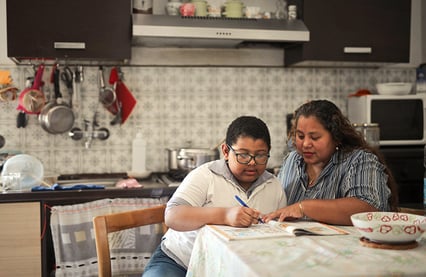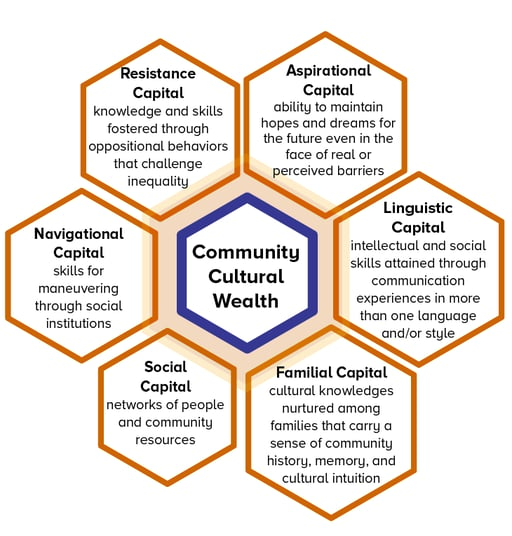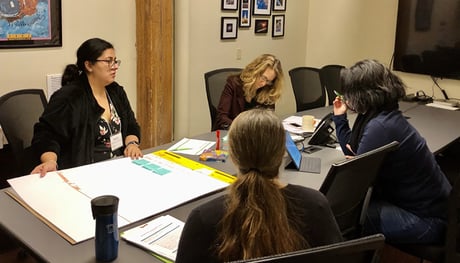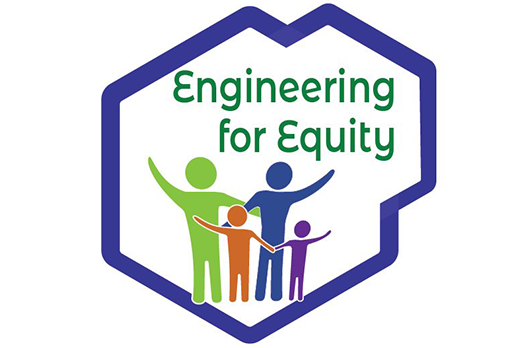TERC Blog
Part 4 - Engineering for Equity: Applying Asset-based Approaches
Applying Asset-based Approaches to Advance Equity in Engineering Learning
One of the most prevalent forms of contemporary racism in US schools is deficit thinking. Deficit thinking takes the position that minority students and families are at fault for poor academic performance because: (a) students enter school without the normative cultural knowledge and skills; and (b) parents neither value nor support their child’s education.
(Yosso, 2005 p.75)
Welcome back to the Engineering for Equity blog series. As discussed in previous posts, our conversations and readings over the last year have made us rethink assumptions about families and how we approach our research to support engineering learning for children and parents. In today’s post, we share more about our shifting ideas for advancing equity in engineering learning. In particular, we discuss the importance of rejecting deficit-based views and narratives, which permeate the US educational system, and instead embracing asset-based perspectives that value the strengths, culture, and diversity of families. For us as engineering education researchers, we believe incorporating asset-based perspectives is critical for not only supporting the development of engineering knowledge and skills for families but ultimately working with them to expand and redefine engineering. We start this post by presenting examples of asset-based frameworks that we have found relevant. We then discuss connections to engineering education and outline a set of the reflective questions we have used to guide our own work.
Recognizing and Valuing Strengths
Early in our reflective process, the use of asset-based perspectives emerged as an important and promising approach to shift diversity, equity, and inclusion efforts in STEM education (Denton et al., 2020). Asset-based approaches focus on recognizing and valuing the strengths of individuals and communities, rather than emphasizing the challenges and disadvantages that communities face engaging in White-dominant systems (Ladson-Billings, 2007). These challenges can often be so great that they make us lose sight of the resilience, strength, and resourcefulness that is present in each community. It can also lead researchers and practitioners to focus on “solutions” or ways to remediate the perceived problems rather than acknowledging and working to disrupt power structures or oppressive systems that are in place. We have been culpable of this in our work in the past and are working to shift our perspectives. For example, in the proposal development process, we often spend considerable energy articulating the “perceived problems” (e.g., need for career pipelines and diversifying the workforce) we want to solve “for” communities through our work rather than collaborating with community members to understand their broader goals and priorities.

In our work with families in the Head Start on Engineering project, we have seen many examples of the assets that families bring to their engagement with engineering. For example, when we checked-in with Daniela, a parent that participated in the program a year prior to our conversation, she spoke about what they had been doing at home related to engineering. Daniela and her son wanted to create a picture board for decoration. In the middle of the project, they ran out of glue. Daniela said:
Cuando se acabó el pegamento utilizamos la harina como pegamento. Me recordé cuando era niña y le enseñé como buscar opciones. [When we ran out of glue, I used flour to make glue. It reminded me of when I was a child, so I taught (my son) how to find other solutions.]
Rather than let this barrier or other circumstances stop them, Daniela drew from her own childhood experiences and used materials in the house to engineer a solution to the problem. Reflecting on her broader experience after the program, she added:
La verdad es que no he tenido apoyo. Una vez se acabó el programa no he tenido oportunidades. Económicamente no se nos hace fáciles para hacer proyectos. Como le dije tuvimos que utilizar la harina por que no podía comprar pegamento. No quería que se me escapara ese momento y decidí hacerlo. Estoy motivada para buscar recursos y oportunidades. [The truth is that I haven’t had much support. I haven’t had many opportunities after the program ended. Things aren’t easy economically, especially for doing projects like this. Like I mentioned, we had to use flour as glue because I couldn’t purchase glue. I didn’t want to let the moment pass, so I just decided to use the flour. I am motivated to look for new resources and opportunities.]
Throughout our conversation, Daniela seemed empowered by the recognition that she had engaged in the engineering design process. And we can only imagine how powerful this experience was for her child, who was able to experience first-hand the resiliency and ingenuity of his mother. This along with many other experiences have expanded our views of what it means for families to engage with engineering and is helping us think more deeply about how we design programs and learning experiences in collaboration with communities.
Talk the Talk and Walk the Walk
While many researchers and educators explicitly oppose deficit-based approaches and recognize the value of asset-based perspectives, one challenge is that only a few studies detail what an asset-based approach looks like, especially when we consider engagement with engineering. While there is some consensus that asset-based practices involve the value and incorporation of individuals’ cultural practices (Aronson & Laughter, 2016; Darling-Hammond et al., 2020), the concept still remains abstract. For some educators and researchers, the goal of employing asset-based pedagogies might be tied to disrupting unjust educational systems while for others it is more about increasing knowledge or skills of underrepresented individuals so they can “fit better” or “assimilate” within certain disciplines. A promising tool to help us untangle these ideas is the development and application of asset-based frameworks. Many of these frameworks are grounded in Critical Race Theory (CRT) and encourage researchers and educators to recognize and value assets without judging communities against White normative standards (Ladson-Billings & Tate, 1995).
In our exploration we came across a subset of asset-based frameworks that have been applied when exploring engagement with STEM. Among these were Funds of Knowledge (González et al., 2005), Third Space (Soja, 1996, Moje et al., 2004), Community Cultural Wealth (CCW) (Yosso, 2005), and Family Resilience Framework (FRF)(Walsh, 2003). These frameworks have helped researchers better understand and build on participants’ assets. However, many of them remain in the context of formal education, focusing primarily on developing curriculum and inclusive teaching practices.
Two Promising Frameworks for Guiding Equity Work with Families
While there is much we can learn about asset-based frameworks from formal education settings, it was important for us to consider what these frameworks and practices look like when working with families with young children in informal education spaces like the home. Two asset-based frameworks, CWW and FRF, were of particular interest to our work because they have been applied more broadly to understand family assets and how those influence STEM engagement. Furthermore, we were inspired by the goals expressed by the scholars that developed the frameworks of “transforming education” and “empowering people of color to utilize assets abundant in their communities” (Walsh, 2003; Yosso, 2005). In other words, these types of frameworks can help us as researchers disrupt the systems that we have often inadvertently supported.
The Community Cultural Wealth (CCW) framework was developed by Yosso (2005) using Critical Race Theory to challenge traditional interpretations of cultural capital. Yosso describes CCW as “an array of knowledge, skills, abilities and contacts possessed by Communities of Color to survive and resist macro and micro-forms of oppression” (p. 77). She describes six forms of capital that are part of CCW and are often unacknowledged or unrecognized within communities of color: aspirational, linguistic, familial, social, navigational, and resistance (see image below).

The Family Resilience Framework (FRF) was developed by Walsh (2003) initially to guide clinical interventions for families. The framework is grounded in family systems theory (Bowen, 1978; Broderick, 1993; Cox & Paley, 1997) and describes the components that contribute to building family resilience, which is defined by Walsh as “the ability to struggle well with a focus on the future” (p.132). This framework has recently been applied to challenge deficit perspectives and describe the experiences of Latinx families during the transition from preschool to kindergarten (Coba-Rodriguez et al., 2020). In this study, the authors found that Latina mothers are resilient and resourceful in the face of challenges like poverty and that they engage their preschoolers in varied learning activities that prepare them for kindergarten.
As outlined by Walsh, some of the key processes that support family resilience include:
- Belief system—shared beliefs that help families make meaning of hard situations and facilitate a positive outlook
- Organizational patterns—patterns like flexibility, shared leadership, mutual support, and connection that help build resilience
- Communication processes—the ability to communicate openly, share emotions, and engage in collaborative problem solving
Implications for our Work
While the use of asset-based frameworks has been shown to be a powerful approach and important step in the journey towards equity, we want to reflect on and think critically about how the frameworks ground our work and what they look like in practice. Here are some of the questions we are currently asking ourselves.
What is the goal of engaging families with engineering?
As we develop programs or research studies, one of the first things we often do as researchers is craft an argument that explains a perceived problem. Then we articulate goals for the project, strategies, and outcomes. While there may not appear to be anything inherently wrong with this process, one of the things we are currently trying to do is work with communities and families to better understand what they think are meaningful questions, goals, and outcomes while articulating how the project can authentically contribute to these. We aspire to develop goals that are not geared towards remediating or fixing individuals or communities but rather fixing or reshaping systems—like education research or family engagement programs. For example, our work with families with young children has shifted over the years to better understand the way that families already use engineering design skills in their lives to solve everyday problems. Through this understanding, we hope to empower families and work alongside them to disrupt an educational system that often fails to value their knowledge and experiences.
How are families participating in the research?
We have been thinking deeply about the ways we engage families through our research. As discussed in our last post, we aspire for our work to be relational and reciprocal, with the researcher giving as much as they are asking from participants. As we noted, the work of Christine McWayne with Head Start families provides an example of family-school partnerships that contribute to creating culturally inclusive environments for all families (McWayne et al., 2021). We also want to involve families across all levels of the work, helping co-develop and co-construct knowledge. In the next post, we will share more about a newly NSF-funded project in which we hope to advance this goal by engaging Latinx parents as researchers to explore how home-based engineering activities can support the development of executive function skills.
What strategies will help ensure the work is truly-asset based?
While we are embracing the application of asset-based frameworks, we are also concerned that without constant reflection and accountability the work won’t be truly asset based. In the systematic literature review conducted by Denton, Borrego, and Boklage (2020) to explore the application of Yosso’s CCW framework in STEM education, the authors identified multiple instances where CCW was used in deficit-based statements and contributed to damaging stereotypes about communities. The authors encouraged practitioners to be careful of how they adopt the framework and reflect on the original intentions of the authors. Without additional strategies, constant reflection, and input, we run the risk of doing more harm than good to the communities we work with. One promising strategy we have been employing is working with an equity coach. In a recent project, for example, the equity coach is a part of the project team and provides mentoring and evaluation of our equity strategies and approaches. They conduct observations of project activities, meet with project team members to discuss strategies, and regularly share their reflections. We have found this collaboration to be rewarding for both researchers and families and an essential mechanism for accountability to our long-term equity goals.
Navigate to other blog posts in this series here:
- Introduction - Engineering for Equity
- Family Collaboration, post 1
- Family collaboration, post 2
- Applying Asset-based Approaches
- Engineering and Executive Function Skills, post 1
- Engineering and Executive Function Skills, post 2
- Engaging Families with Engineering, post 1
About the Authors
Smirla Ramos Montañez, PhD, is a bilingual (Spanish/English) and bicultural (Puerto Rican/American) Family STEM Learning Researcher at TERC. She has led and supported a variety of projects, including program and exhibit evaluation as well as STEM education research designed to provide accessible, culturally relevant, and engaging experiences for diverse audiences. She is currently the PI of the Diálogos project, which will engage parents as research partners to explore how we can leverage informal family engineering activities to support the development of executive function skills for preschool-age children from Latinx families.
Scott Pattison, PhD, is a Research Scientist at TERC. He has been studying and supporting STEM education and learning since 2003, as an educator, program and exhibit developer, evaluator, and researcher. His current work focuses on engagement, learning, and interest and identity development in free-choice and out-of-school environments, including museums, community-based organizations, and everyday settings. He has led numerous informal STEM education research projects and initiatives, including Head Start on Engineering, Storybook STEM, Math in Making, and REVEAL.
References
Aronson, B., & Laughter, J. (2016). The theory and practice of culturally relevant education: A synthesis of research across content areas. Review of Educational Research, 86(1), 163–206.
Bowen, M. (1978). Family therapy in clinical practice. Aronson.
Broderick, C. B. (1993). Understanding family process: Basics of family systems theory. Sage Publications.
Coba-Rodriguez, S., Cambray-Engstrom, E., & Jarrett, R. L. (2020). The home-based involvement experiences of low-income Latino families with preschoolers transitioning to kindergarten: Qualitative findings. Journal of Child and Family Studies, 29(10), 2678–2696. https://doi.org/10.1007/s10826-020-01781-7
Cox, M. J., & Paley, B. (1997). Families as systems. Annual Review of Psychology, 48(1), 243–267.
Darling-Hammond, L., Flook, L., Cook-Harvey, C., Barron, B., & Osher, D. (2020). Implications for educational practice of the science of learning and development. Applied Developmental Science, 24(2), 97–140. https://doi.org/10.1080/10888691.2018.1537791
Denton, M., Borrego, M., & Boklage, A. (2020). Community cultural wealth in science, technology, engineering, and mathematics education: A systematic review. Journal of Engineering Education, 109(3), 556–580. https://doi.org/10.1002/jee.20322
González, N., Moll, L. C., & Amanti, C. (2005). Funds of knowledge: Theorizing practice in households, communities, and classrooms. Erlbaum.
Ladson-Billings, G. (2007). Pushing past the achievement gap: An essay on the language of deficit. The Journal of Negro Education, 76(3), 316–323.
Ladson-Billings, G., & Tate, W. F. (1995). Toward a critical race theory of education. Teachers College Record, 97(1), 47–68. https://doi.org/10.1080/10282580701850413
McWayne, C., Hyun, S., Diez, V., & Mistry, J. (2021). “We feel connected… and like we belong”: A parent-led, staff-supported model of family engagement in early childhood. Early Childhood Education Journal. https://doi.org/10.1007/s10643-021-01160-x
Walsh, F. (2003). Family resilience: A framework for clinical practice. Family Process, 42(1), 1–18. https://doi.org/10.1111/j.1545-5300.2003.00001.x
Yosso, T. J. (2005). Whose culture has capital? A critical race theory discussion of community cultural wealth. Race Ethnicity and Education, 8(1), 69–91. https://doi.org/10.1080/1361332052000341006






